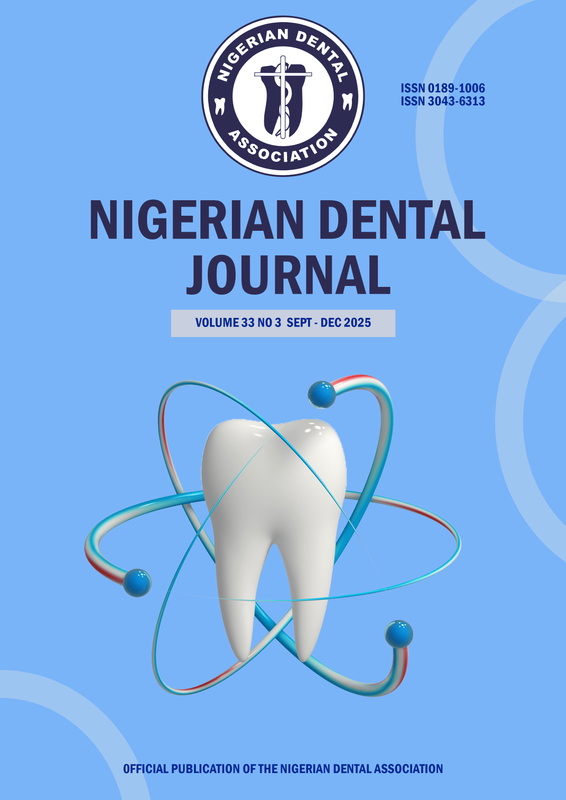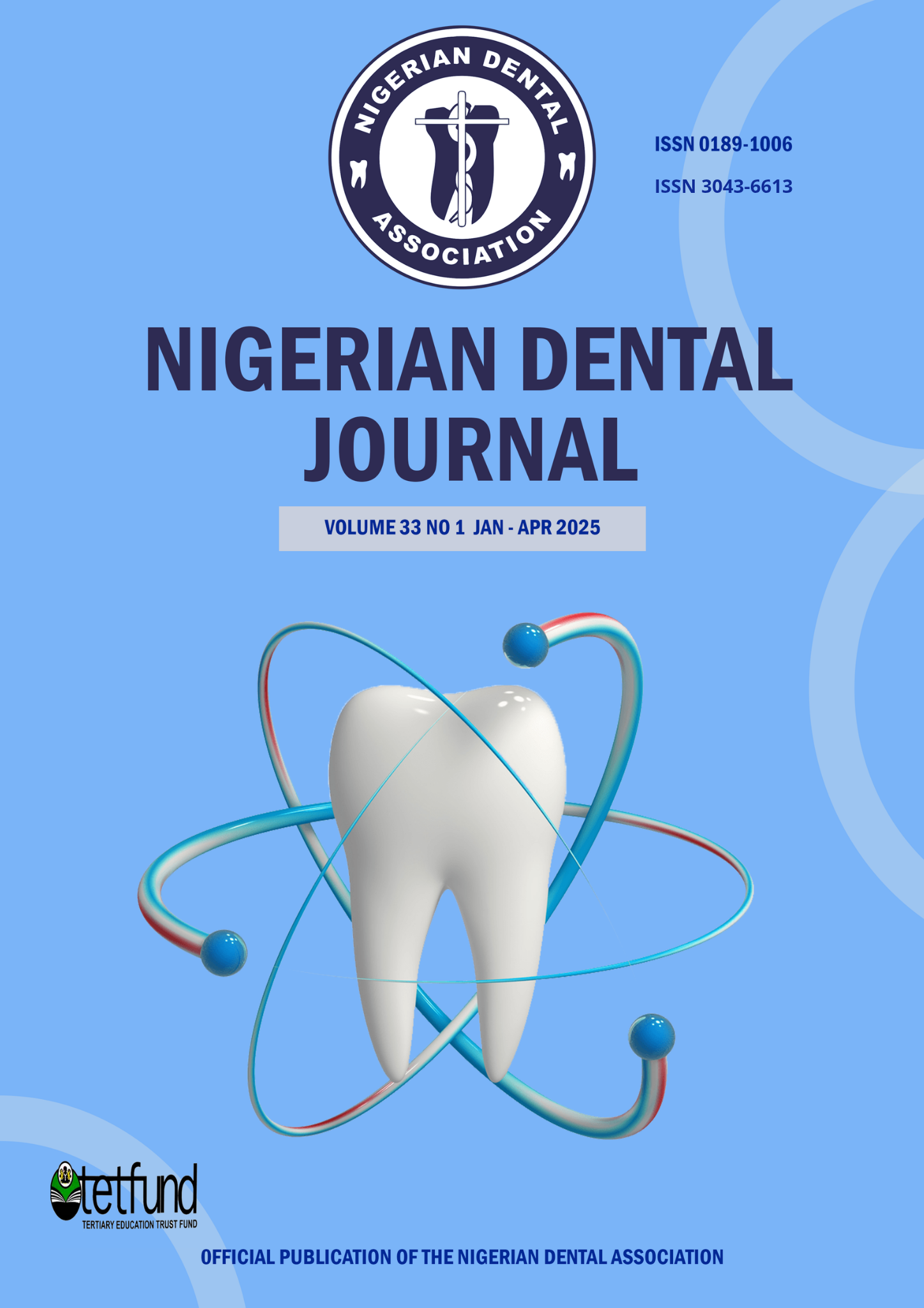TIME TO ALIGNMENT OF ANTERIOR SEGMENT CROWDING TREATED WITH NiTi AND COPPER NiTi ARCH WIRES
DOI:
https://doi.org/10.61172/93tpgf43Keywords:
Time to alignment, Anterior segment crowding, NiTi arch wire, Copper NiTi arch wireAbstract
Abstract
Introduction
Treatment duration and cost are integral aspects of orthodontic treatment planning and are required to predict outcomes. Shorter treatment regimens prevent the adverse effects of orthodontic treatment. Contemporary arch wires have properties that potentially shorten orthodontic treatment time. This study aimed to determine the time to alignment of anterior segment crowding with NiTi and CuNiTi arch wires.
Methods:
A randomized controlled trial carried out at the Orthodontic unit of a tertiary hospital. Thirty-two arches with Little’s Irregularity Index (LII) of ≥ 4mm on anterior permanent teeth were involved in the study. The LII was measured on study models at pre-treatment and after commencement of orthodontic treatment, at each review visit until it reduced to 3.0mm or less.
The results were analyzed on the Statistical Package for Social Sciences Chicago Inc. V. with Mann-Whitney U test, Kaplan-Meier methods, the Log rank test and Cox regression at p<0.05.
RESULTS:
The arches had moderate 22 (34.3%), severe 25 (39.1%) and very severe 17 (26.6%) crowding. The mean time to alignment was 55.69 ± 20.18 days (CuNiti) and 67.19±33.91 days (Niti). The time to resolution of crowding for 50% of the arches was similar for the wires (p =0.07). The resolution of crowding was 0.77 times higher with CuNiTi wires. Arches with initial severe crowding had a 4.56 increase in the time to alignment with every 1 mm increase in their LII (p value ˂0.05).
Conclusion
The time to alignment of anterior segment crowding with NiTi and CuNiTi arch wires was similar.
Downloads
References
REFERENCES
Onyeaso CO, Aderinokun GA, Arowojolu MO. The pattern of malocclusion among orthodontic patients seen in Dental Centre, University College Hospital, Ibadan, Nigeria. Afr J Med Med Sci. 2002 Sep;31(3):207–11.
Utomi IL, Onyeaso CO. Anteroposterior, vertical and space malocclusions in adolescents with special needs in Lagos, Nigeria. Odontostomatol Trop. 2011 Jun;34(134):17–23.
Sanu OO, Isiekwe MC. A 5-year retrospective audit of orthodontic services in a tertiary hospital. Nig Q J Hosp Med. 2011;21(4):312–6.
Kolawole KA, Ayeni OO, Osiatuma VI. Psychosocial impact of dental aesthetics among university undergraduates. Int Orthod. 2012 Mar;10(1):96–109.
Onyeaso CO, Sanu OO. Psychosocial implications of malocclusion among 12-18 year old secondary school children in Ibadan, Nigeria. Odontostomatol Trop. 2005 Mar;28(109):39–48.
Seehra J, Newton JT, Dibiase AT. Bullying in schoolchildren - Its relationship to dental appearance and psychosocial implications: An update for GDPs. Br Dent J. 2011;
Daniela Feu, Branca H Oliveira, Roger K. Celeste, Jose Augusto M.Miguel. Influence of orthodontic treatment on adolescents’ self-perception of esthetics. Am J Orthod Dentofac Orthop. 2012;141:743–50.
Seehra J, Newton JT, Dibiase AT. Interceptive orthodontic treatment in bullied adolescents and its impact on self-esteem and oral-health-related quality of life. Eur J Orthod. 2013;
Moresca R. Orthodontic treatment time: Can it be shortened? Dental Press J Orthod. 2018;23(6):90–105.
Yildiz O, Yagci A, Hashimli N. Effect of applying intermittent force with and without vibration on orthodontic tooth movement. J Orofac Orthop. 2023;
Uribe F, Padala S, Allareddy V, Nanda R. Patients’, parents’, and orthodontists’ perceptions of the need for and costs of additional procedures to reduce treatment time. Am J Orthod Dentofac Orthop. 2014;145(4 SUPPL.).
Eberting J., Straga S., Tuncay O. Treatment time, outcome and patient satisfaction. Comparisons of Damon and Conventional brackets. Clin Orthod Res. 2001;4:228–34.
Bowman SJAY. The Effect of Vibration on the Rate of Leveling and Alignment. 2014;(November):678–88.
Dalstra M, Melsen B. Does the transition temperature of Cu-NiTi archwires affect the amount of tooth movement during alignment? Orthod Craniofac Res. 2004 Feb;7(1):21–5.
Pandis N, Polychronopoulou A, Eliades T. Alleviation of mandibular anterior crowding with copper-nickel-titanium vs nickel-titanium wires: A double-blind randomized control trial. Am J Orthod Dentofac Orthop. 2009;136(2):152.e1-152.e7.
Abdelrahman RS, Al-Nimri KS, Al Maaitah EF. A clinical comparison of three aligning archwires in terms of alignment efficiency: A prospective clinical trial. Angle Orthod. 2015;85(3):434–9.
Williams J., Isaacson K., Cook P., Thom A. Fixed Orthodontic Appliances: Principles and practice. 1st ed. Oxfordi: wright; 1997. 21–34 p.
Nikolai RJ. Orthodontic wire: a continuing evolution. Semin Orthod. 1997;3(3):157–65.
Gravina MA, Helena I, Portella V, Canavarro C. Mechanical properties of NiTi and CuNiTi shape-memory wires used in orthodontic treatment . Part 1 : Stress-strain tests. 2013;18(4):35–42.
Kusy RP. Orthodontic Biomaterials : From the Past to the Present. Angle Orthod. 2002;72(6):501–12.
Proffit W, Fields HW, Sarver DM. Contemporary Orthodontics. 4th ed. St Louis, Missouri: Mosby Elsevier; 2007.
Kapila S, Sachdeva R. Mechanical properties and clinical applications of orthodontic wires. Am J Orthod Dentofac Orthop. 1989;96(Table I):100–9.
Buehler W, Gilfrich J, Wiley R. Effect of Low temperature phase changes on the mechanical properties of alloys near composition TiNi. J Appl Phys. 1963;34:1475–7.
Kusy RP. A review of contemporary arch wires: Their properties and characteristics. Angle Orthod. 1997;67(3):197–208.
Andreasen G, Hilleman T. An evaluation of 55 cobalt substituted Nitinol wire for use in orthodontics. J Am Dent Assoc. 1971;82:1373–5.
Sachdeva RCL, Miyazaki S, Farzin-nia F. Orthodontic archwire and method of moving teeth. [Internet]. Vol. 9. United States of America: United States Patent; 5,044,947, 1991. p. 1–6.
Melson B. Biological reaction of alveolar bone to orthodontic tooth movement. Angle Orthod. 1999;69(2):151–8.
Mavreas D, Athanasiou AE. Factors affecting the duration of orthodontic treatment : a systematic review. 2008;30(March 2005):386–95.
Jian F, Lai W, Furness S, GT M, Millett D, Hickman J, et al. Initial arch wires for tooth alignment during orthodontic treatment with fixed appliances ( Review ). Cochrane Database Syst Rev. 2013;4(CD 007859).
Pandis N, Polychronopoulou A, Eliades T. Alleviation of mandibular anterior crowding with copper Niti vs NiTi wires: A double blind randomized controlled trial. Am J Orthod Dentofac Orthop. 2009;136:151–7.
Gravina MA, Canavarro C, Elias CN, Afonso G, Chaves M. Mechanical properties of NiTi and CuNiTi wires used in orthodontic treatment . Part 2 : Microscopic surface appraisal and metallurgical characteristics. Dent Press J Orthod. 2014;19(1):69–76.
Little RM. The irregularity index: A quantitative score of mandibular anterior alignment. Am J Orthod. 1975;68:554–63.
Koletsi D, Pandis N. Survival analysis, part 2: Kaplan-Meier method and the log-rank test. Am J Orthod Dentofac Orthop. 2017;152(4):569–71.
Koletsi D, Pandis N. Survival analysis, part 1: Introduction. Am J Orthod Dentofac Orthop. 2017;152(3):428–30.
Staub L, Gekenidis A. Kaplan-Meier Survival Curves and the Log- Rank. 2011.
Koletsi D, Pandis N. Survival analysis, part 3: Cox regression. Am J Orthod Dentofac Orthop. 152(5):722–3.
Vijayalakshmi RD, Nagachandran KS, Kummi P, Jayakumar P. A comparative evaluation of metallurgical properties of stainless steel and TMA archwires with timolium and titanium niobium archwires--an in vitro study. Indian J Dent Res. 2009;20(4):448–52.
Santoro M, Nicolay O., Cangialosi TJ. Psuedoelasticity and thermoelasticity of nickel-titanium alloys: a clinically oriented review. Part 1: Temperature transitional ranges. Am J Orthod Dentofac Orthop. 2001;119:587–9.
Nosalik K, Maciej K. Contemporary NiTi Archwires – Mechanical Properties. Dent Med Probl. 2012;49(3):433–7.
Rosen MA. Mechanical Properties of Copper-Nickel-Titanium Archwires. Marquette University; 2016.
Ong E, Miles P. Alignment efficiency and discomfort of three orthodontic archwire sequences : a randomized clinical trial. 2011;38:32–9.
Cobb III N., Kula K., Phillips C, Proffit WR. Efficiency of multi-strand steel, superelasltic Ni-Ti and ion-implanted Ni-Ti archwires for initial alignment. Clin Orthod Res. 1998;1(1):12–9.
Downloads
Published
Issue
Section
License
Copyright (c) 2025 Fechi Nkwocha , Clara Akinyamoju, Orighoye Temisanren, Oluranti daCosta, Obafunke Denloye

This work is licensed under a Creative Commons Attribution 4.0 International License.
Open Access Statement
- We became fully Open Access since January 2023.
- Our new and archived materials are available free of charge on open basis and under a Creative Commons license as stated below.
Copyright statement
Copyright © 1999 The authors. This work, Nigerian Dental Journal by Nigerian Dental Association is licensed under Creative Commons Attribution 4.0 International License.


